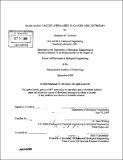Yeast-based vaccine approaches to cancer immunotherapy
Author(s)
Howland, Shanshan W
DownloadFull printable version (19.40Mb)
Other Contributors
Massachusetts Institute of Technology. Biological Engineering Division.
Advisor
K. Dane Wittrup.
Terms of use
Metadata
Show full item recordAbstract
Saccharomyces cerevisiae stimulates dendritic cells and represents a promising candidate for cancer immunotherapy development. Effective cross-presentation of antigen delivered to dendritic cells is necessary for successful induction of cellular immunity. Using a yeast vaccine model, we investigated the phagosome-to-cytosol pathway of cross-presentation. We demonstrate that the rate of antigen release from phagocytosed yeast directly affects cross-presentation efficiency, with an apparent time limit of about 25 min post-phagocytosis for antigen release to be productive. Antigen expressed on the yeast surface is cross-presented much more efficiently than antigen trapped in the yeast cytosol by the cell wall. The cross-presentation efficiency of yeast surface-displayed antigen can be increased by the insertion of linkers susceptible to cleavage in the early phagosome. Antigens indirectly attached to yeast through antibody fragments are less efficiently cross-presented when the antibody dissociation rate is extremely slow. Next, we present a yeast-based cancer vaccine approach that is independent of yeast's ability to express the chosen antigen, which is instead produced separately and conjugated to the yeast cell wall. The conjugation method is site-specific (based on the SNAP-tag) and designed to facilitate antigen release in the dendritic cell phagosome and subsequent translocation for cross-presentation. (cont.) Phagosomal antigen release was further expedited through the insertion of the invariant chain ectodomain as a linker, which is rapidly cleaved by Cathepsin S. The dose of delivered antigen was increased in several ways: by using yeast strains with higher surface amine densities, by using yeast cell wall fragments instead of whole cells, and by conjugating multiple layers of antigen. The novel multi-layer conjugation scheme is site-specific and takes advantage of Sfp phosphopantetheinyl transferase, enabling the antigen dose to grow linearly. We show that whole yeast cells coated with one layer of the cancer-testis antigen NY-ESO-1 and yeast hulls bearing three layers were able to cross-prime naive CD8+ T cells in vitro, with the latter resulting in higher frequencies of antigen-specific cells after ten days. This cross-presentation-efficient antigen conjugation scheme is not limited to yeast and can readily be applied towards the development of other particulate vaccines.
Description
Thesis (Ph. D.)--Massachusetts Institute of Technology, Biological Engineering Division, 2008. Includes bibliographical references.
Date issued
2008Department
Massachusetts Institute of Technology. Department of Biological EngineeringPublisher
Massachusetts Institute of Technology
Keywords
Biological Engineering Division.